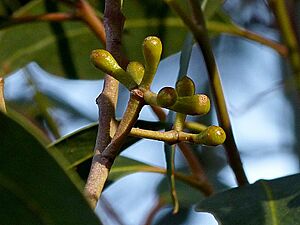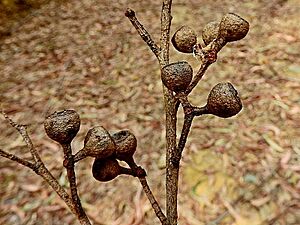Yellow stringybark facts for kids
The Yellow Stringybark (Eucalyptus muelleriana) is a type of tree found only in southeastern Australia. It's known for its rough, stringy bark on its trunk and branches. This tree has long, curved leaves, white flowers, and fruit that looks like a small cup.
Quick facts for kids Yellow stringybark |
|
|---|---|
 |
|
| Eucalyptus muelleriana in the Royal Botanic Garden, Melbourne | |
| Scientific classification | |
| Genus: |
Eucalyptus
|
| Species: |
muelleriana
|
| Synonyms | |
|
|
Contents
About the Yellow Stringybark Tree
The Yellow Stringybark is a medium to tall tree. It can grow up to 40 m (130 ft) (about 130 feet) high. It has rough, greyish, stringy bark that covers its trunk and even its thinner branches.
Leaves and Flowers
Young Yellow Stringybark plants have shiny, dark green leaves. These leaves are shaped like a spear. They are about 55–135 mm (2.2–5.3 in) (2-5 inches) long.
Adult trees have glossy green leaves that are a bit paler underneath. These leaves are also spear-shaped or slightly curved. They can be 80–200 mm (3.1–7.9 in) (3-8 inches) long.
The tree's flower buds grow in groups of seven, nine, or eleven. They are oval-shaped and about 5–7 mm (0.20–0.28 in) (0.2-0.3 inches) long. The flowers are white and usually bloom between January and May.
Fruit
After flowering, the tree produces woody fruit. This fruit is shaped like a cup or a shortened ball. It is about 6–10 mm (0.24–0.39 in) (0.2-0.4 inches) long and 7–12 mm (0.28–0.47 in) (0.3-0.5 inches) wide.
Tree Name and History
The Yellow Stringybark was first officially described in 1891. A scientist named Alfred William Howitt gave it the scientific name Eucalyptus muelleriana. The "muelleriana" part of its name honors another famous scientist, Ferdinand von Mueller.
Where Yellow Stringybark Grows
This tree naturally grows in wet forests. You can find it along the coast and in the mountain ranges of southeastern Australia. Its range stretches from Wollongong in New South Wales down to Wilsons Promontory in Victoria. It has also been planted in New Zealand.
Uses of Yellow Stringybark Wood
The wood from the Yellow Stringybark is very useful. It is strong, lasts a long time, and has a straight grain. Because of these qualities, it has been widely used. In Victoria, for example, it was often used for making fence posts and piles (strong supports for buildings or structures).
See also
 In Spanish: Corteza fibrosa para niños
In Spanish: Corteza fibrosa para niños



